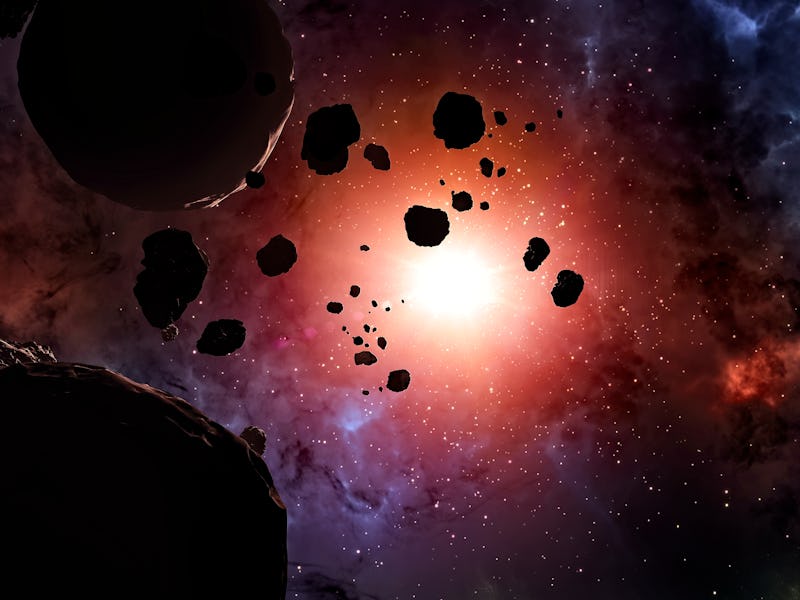NASA just directed its Lucy mission to target a skyscraper-sized asteroid
We only have to wait a few months for NASA’s Lucy spacecraft to visit its first asteroid.

NASA’s Lucy mission will target its first asteroid later this year, kick-starting its exploration of our Solar System’s origins much sooner than planned.
In a Wednesday announcement, the space agency said that its Lucy spacecraft, which launched on October 16, 2021, will target a small rock located between Mars and Jupiter in the main asteroid belt on November 1, 2023. Up until now, Lucy has spent a year and a half in flight. It's performed one gravitational flyby of Earth to reach a mysterious population of asteroids adrift near Jupiter known as Trojans. The newest member of its rocky roster, designated 1999 VD57, is now the first asteroid that Lucy will study, two years ahead of what used to be its first-assigned asteroid flyby in 2025.
The upcoming rendezvous with 1999 VD57 will help Lucy “conduct an engineering test of the spacecraft’s innovative asteroid-tracking navigation system,” NASA officials wrote.
This is critical: Lucy is on a quest to learn about seven ancient oddities, called Jupiter Trojans. And reaching them is tricky, because these asteroids orbit the Sun in two big pockets ahead of and behind Jupiter. To visit so many Trojans, and to catch a few main belt asteroids on its way to them, Lucy will have to navigate with great precision. Lucy must weave in and out of the inner Solar System, perform two more gravity assists (in 2024 and 2030), train its three instruments, and graze the space around the asteroids. The newest flyby of 1999 VD57 brings Lucy’s asteroid flyby itinerary up to nine.
A Trojan asteroids illustration.
Lucy’s timeline
- November 1, 2023 – Lucy encounters 1999 VD57 in the main asteroid belt
- December 12, 2024 – Lucy performs its second Earth gravity assist
- April 20, 2025 – Lucy encounters asteroid Donaldjohansen in the main asteroid belt
- August 12, 2027 – Lucy encounters its first Trojans, called Eurybates and Queta
- September 15, 2027 – Lucy visits the Trojan asteroid Polymele
- April 18, 2028 – Lucy encounters the Trojan asteroid Leucus
- November 11, 2028 – Lucy visits the Trojan asteroid Orus
- December 25, 2030 – As it cuts across the inner Solar System from one Trojan swarm to the next, it performs its third Earth flyby and gains a gravity assist
- March 3, 2033 – Lucy visits the Trojan asteroid pair Patroclus and Menoetius. The mission ends, and the spacecraft will continue adrift for possibly millions of years.
The new asteroid target
With millions of asteroids in the main asteroid belt, the Lucy team figured there’d be at least one new rock worth a close look.
Raphael Marschall, a Lucy mission collaborator at the Nice Observatory in France, identified asteroid 1999 VD57 as “an object of special interest for Lucy,” NASA said.
According to the announcement, Marschall selected 500,000 asteroids with well-defined orbits “to see if Lucy might be traveling close enough to get a good look at any of them, even from a distance.
“This asteroid really stood out,” Marschall says. “Lucy’s trajectory as originally designed will take it within 40,000 miles of the asteroid, at least three times closer than the next closest asteroid.”
In this animation, the Trojans appear as green dots. The circles are the orbits of the inner Solar System planets and Jupiter.
What’s in a name?
Lucy is the name of the Australopithecus fossil found in Hadar, Ethiopia in 1974. Lucy comes from a species that was related to ancient humans. The NASA mission named the spacecraft after this finding, because much like Trojan asteroids are relics from the early Solar System, Lucy’s skeleton revealed clues about hominin evolution and revolutionized our understanding of human bipedalism and brain development.
In a similar sentiment, NASA describes Trojans as “time capsules from the birth of our Solar System more than 4 billion years ago.”
These “primitive bodies,” as NASA calls them, orbit the Sun in gravitationally-stable points within Jupiter’s orbit. Trojans are found in two main swarms. Lucy will visit them both over the next decade.